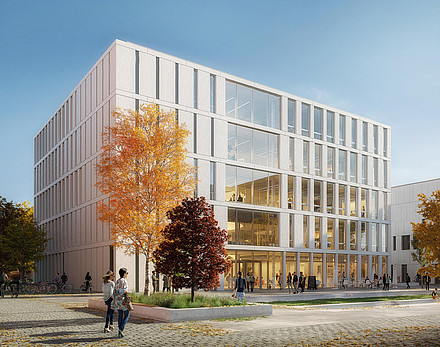In Portrait | The Research Center "Der Simulierte Mensch” (The Simulated Human) (Si-M)

"Completely new opportunity for joint research"
What is special about Si-M is that the future teams will come from both, Technische Universität Berlin and Charité - Universitätsmedizin Berlin. Both institutions will jointly manage the research center. "There will be no separate premises for exclusively TU Berlin or Charité, so the scientists will work in mixed laboratories and offices on joint projects without separation," says Shirin Kadler, scientific coordinator at Si-M. "Real interdisciplinary work will thus be possible at Si-M."
The construction of Si-M was jointly applied for almost five years ago by Prof. Roland Lauster, former Head of the Department of Medical Biotechnology at TU Berlin, and Prof. Andreas Thiel, Head of the Regenerative Immunology and Aging Group at Charité and the Berlin Institute of Health. After the Science Council recommended the construction of Si-M in Berlin in April 2018 and the architectural firm Telluride (former HDR) won the tender a year later, the ground was broken at the end of 2020.
Since then, construction has been underway on the five-story building on Seestraße in Berlin-Wedding, in the neighborhood of Charité's Virchow-Klinikum campus. The estimated costs of 34 million euros are being covered proportionally by the federal government and the state of Berlin as part of the program for research buildings at universities.
Around two-thirds of the space for laboratories
Of the approximately 3,770 square meters of usable space, two-thirds is available for the three laboratory levels - 'Subcellular', 'Cellular', 'Tissue'. "Here, researchers from a wide range of disciplines at Charité and TU Berlin come into direct contact with each other," explains Andreas Thiel, "Even now, boundaries between different scientific cultures are thus overcome in the Si-M research space."
In this way, possible new technologies such as 3D cultivation, multi-organ chips, 3D bioprinting and new multidimensional analyses of cells from the blood or also in tissue samples are to be brought into medically usable processes and applications. Berlin, with Charité and TU Berlin as the driving forces, is a pioneer in this field.
According to Jennifer Rosowski, the Si-M scientific coordinator at Charité, about one-third of the workstations are occupied by permanent groups. "These working groups are leaders in their fields and provide significant support to other Si-M working groups in applying the key technologies mentioned above in-house," Rosowski says. The remaining two-thirds are assigned on a temporary basis. "These projects, funded through acquired third-party funds, already represent the core of Si-M's research programmatic. It is part of the Si-M's research programmatic to thus give young scientists in particular the opportunity to freely implement their research projects," says Rosowski.
First symposium even before moving in
Even before the first employees move into the Si-M, cooperative work is being done on the many studies and projects. For example, studies during the Corona epidemic investigated why COVID-19 can develop into a life-threatening disease in some sufferers and not in many. An interdisciplinary and cross-sectoral European doctoral network "TOP-Gut" has been granted to Si-M scientists train doctoral students in the field of innovative preclinical models with a focus on complex gastrointestinal models (https://topgut.eu/).
Following an initial online networking event in November 2022, Si-M Day, the first "Si-Mposium" took place on September 1st at the Amplifier Berlin, with support from Berlin Partner and others. Among the invited speakers were scientists from renowned institutions such as the Erasmus MC in Rotterdam (Miao-Ping Chien), the Roche Institute for Human Biology in Basel (Nikolche Gjorevski) and King's College London (Joana Neves).
The Si-M will also be available to the public. "In addition to the three laboratory floors mentioned, the future building will have two floors open to the public," says Kadler. Guests could work here as guest scientists, for example, and test subjects will be able to participate in studies here. There will be information events on socially relevant topics, as well as art and cultural events. The public is invited to engage with scientists and vice versa. Spontaneous visits to the Si-M are also possible and will be made attractive - so that the public can always find out what is currently being researched.
Related links:
Website (in German): „Der Simulierte Mensch“ https://www.si-m.org/
Zukunftsprojekt Si-M (in German): https://www.healthcapital.de/das-cluster/zukunftsprojekte-berlin-brandenburg/



